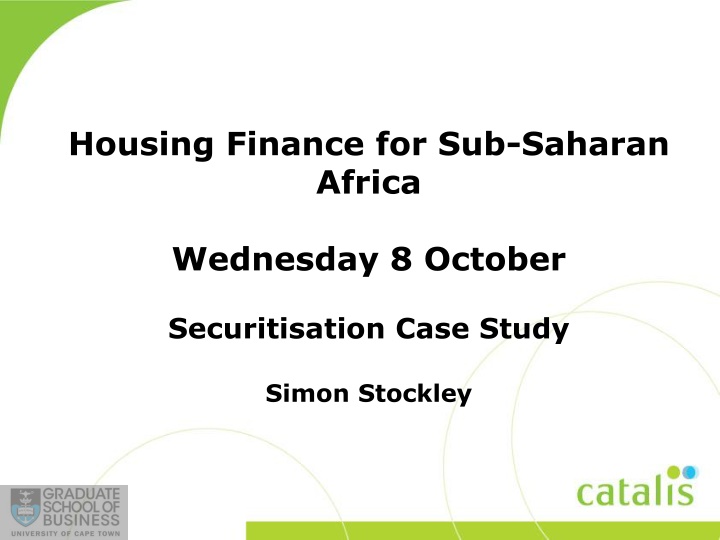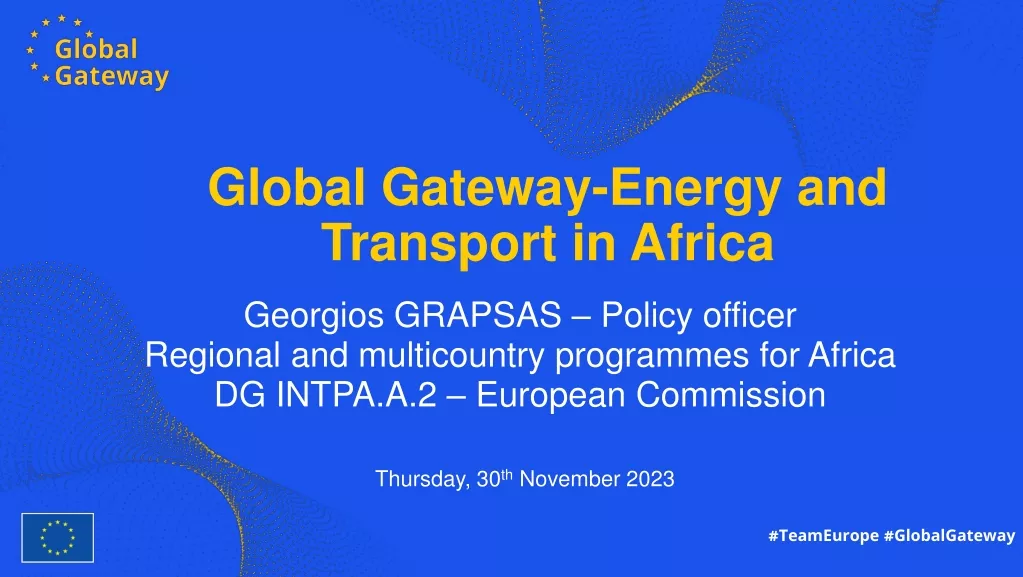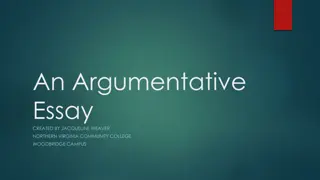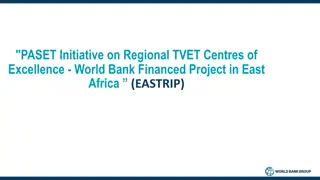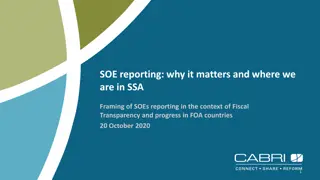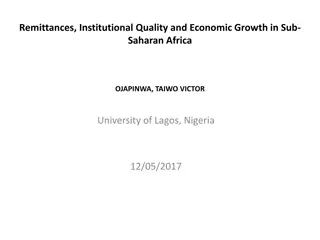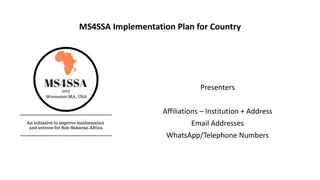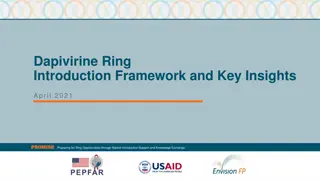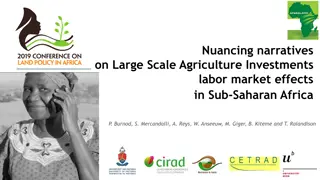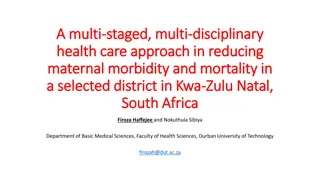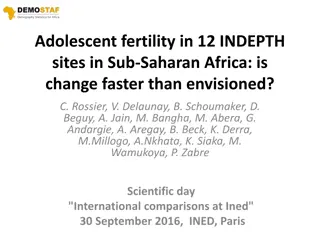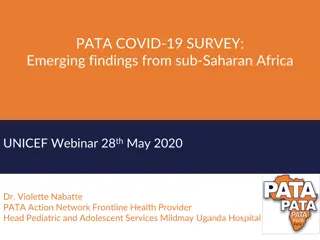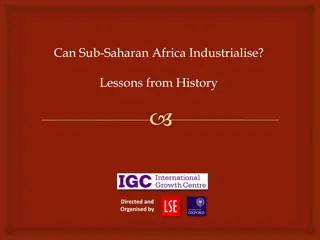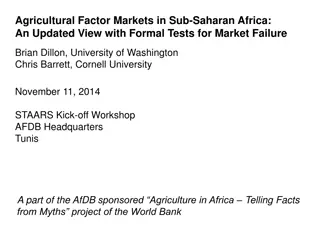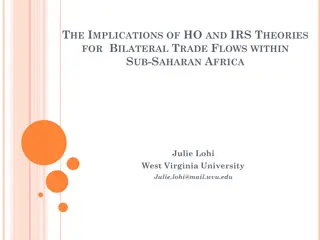Securitisation Case Study in Sub-Saharan Africa: Lessons and Trends
This case study explores the securitisation landscape in Sub-Saharan Africa post-2008 financial crisis, focusing on the Thekweni program, market overviews, and current trends in the South African Debt Capital Market.
Download Presentation

Please find below an Image/Link to download the presentation.
The content on the website is provided AS IS for your information and personal use only. It may not be sold, licensed, or shared on other websites without obtaining consent from the author.If you encounter any issues during the download, it is possible that the publisher has removed the file from their server.
You are allowed to download the files provided on this website for personal or commercial use, subject to the condition that they are used lawfully. All files are the property of their respective owners.
The content on the website is provided AS IS for your information and personal use only. It may not be sold, licensed, or shared on other websites without obtaining consent from the author.
E N D
Presentation Transcript
Housing Finance for Sub-Saharan Africa Wednesday 8 October Securitisation Case Study Simon Stockley
Objectives Practical aspects of theory learnt. Tools to use in your business. Respond/predict where global capital markets are headed post 2008. Generate discussion/interaction. Contents Thekweni program vs. traditional bank funding. KSA Residential Real Estate Backed Securities (RRBS). Lessons learnt along the journey. Q&A.
Current Market Overview Securitisation is gradually returning as a source of alternative financing in the South African Debt Capital Market. Post 2008/2009 crisis, issuance levels spiked around 2011, when a number of bank RMBS deals were being refinanced. The demand is largely due to a return in investor appetite for credit risk, an increase in liquidity and the need for product diversification. Securitisation issuance over the past 2 years has been limited to the established issuers, such as SA Home Loans, BMW, Eskom home loans. Annual securitisation by asset class 50 Syntheti c ABS 40 Billions (R) 30 20 CMBS 10 0 2001 2002 2003 2004 2005 2006 2007 2008 2009 2010 2011 2012
Happy Days, SA Capital Markets Issuance Levels 2000 - 2006 40 35 Total issuances 30 Billions (R) 25 20 Securitised bank issuances 15 10 5 0 2000 2001 2002 2003 2004 2005 2006
Happy Days Continued Cost of Funds 2001 - 2006 Blended cost of funds 0.9 0.8 0.7 0.6 Cost (%) 0.5 0.4 0.3 0.2 0.1 0 Thekweni 1 Thekweni 2 Thekweni 3 Thekweni 4
Current Market Overview Securitisation Market Market Overview Securitisation Market 5 Evolution of Spreads - Price at Issuance for AAA-Rated securitisation Evolution of spreads Price at issuance for AAA rated securitisation bps 260 195 Trend in 5-year Financial Sector spreads since Jan 2012 to date 130 65 0 0 1 2 3 4 5 Years to maturity Source: Standard Bank Research 2010 2011 2012 2013
South African Mortgage Market Overview Sophisticated and mature. Dominated by Big 4 Banks (5/Capitec?). Sound legal structure title & foreclosure. Wide margins no real competition on price, prior to 1998. Historically no non-bank lending prior to launch of SA Home Loans. Traditionally South African banks are cash rich and well capitalized shortage of capital; dynamic changing. Credit data is comprehensive. Deep and advanced capital markets.
Why No Securitisation Prior to December 2001? Big is best. Rating agencies. Exposure to international markets. Legal framework not securitisation friendly; no securitisation regulations prior to 2001. Little incentive for banks to securitise. No ability to reinsure first loss position. Investor education needed. Took a disruptive force .
Traditional Bank Funding - Home Loans Reserving Requirements Loans to Public Long term 20 years min Bank Deposits Short term 3 years max Margin: 4 5% Mismatch Dead capital Contamination
SA Home Loans Securitisation Structure Control External Auditor Independent Trustee Senior Securities Loans to Public Special Purpose Vehicle Trust Public Institutional Investors Jibar + 2.1% Subordinated Securities Origination & Management Fee: 0.5%
Investment Structure A Class 92 % AAA Rating Jibar + 70 points Special Purpose Vehicle R1.25 Bill Public B Class 8% BBB Rating Jibar + 230 points Loans Jibar + 2.1% C Class 2.5% Unrated SAHL Pay away 1.6% to Investors Standard Bank Deloitte & Touche
Advantages of the Structure vs. a Traditional Bank Funding Model Ability to ring fence asset classes and risk profiles. No cross contamination on default. Allows more thinly capitalised entities to access the capital markets, at competitive pricing. Matches term funding more closely with underlying assets. Allows investors to price more appropriately for risk. Encourages competition/benefits consumers. Lower pricing.
Case Study 2 Kingdom of Saudi Arabia Residential Real Estate Backed Securities (RRBS) KSA International Sukuk Company 1 Residential Real Estate Backed Securities Transaction Investor Presentation May 2006
Overview of the KSA Residential Real Estate Market Distribution of KSA loans by lenders 65% of the market is serviced by commercial banks, which offer the cheapest financing but with restrictive eligibility criteria. 8% of the market is serviced by specialized installment companies, that on average charge 2% higher than banks. With a 1.8% mortgage-GDP ration, the KSA market has large growth prospects: 37% of the population lives in rental properties, representing a large current demand for housing finance. Only 10% of new residential properties are currently financed through home loans. KSA economy represents 50% of GDP of GCC. Installment companies Government Developers Commercial banks: Islamic Commercial banks: Coventional Property ownership Apartment owned Vila rented Vila owned Apartment rented
Saudi Arabia Mortgage Finance Market Constraints: Lack of specialist mortgage finance firms. Banks focused on commodity finance and consumer lending. Lack of long term liquidity in the mortgage finance market. Shorter dated financing more readily available. Lack of consumer education with regards to mortgage finance. Lack of commitment to the industry by the majority of players. Lack of a regulated legal system. Lack of a developed swop market.
Sharia Compliant Ijara or Istisna Lease Structure vs. Traditional Mortgage Finance 2. Title and deed Financier (Lessor) Seller 1. Purchase price 3. Ijara Finance Lease or Istisna Agreement 4. (Mortgage) 6. Final payment 5. Rental payments 7. Title and deed Buyer (Lessee)
Sharia Compliant Structures All major/structural maintenance is The Lessor s responsibility. All minor maintenance, due to daily wear and tear, is the Lessee s responsibility. Lessor, responsible to obtain and maintain all required insurance policies. Ownership of the asset must rest with The Lessor. All late payment charges levied against The Lessee must only be for covering the Lessor's administrative costs relating to recovering delinquent payments. Pre-payment penalties must be compensation for a specific loss to the Lessor and not just levied for the purpose of penalizing the Lessee. Rental payment amount must be for a pre-agreed amount only to be amended on mutually accepted terms. Any taxes levied against the asset are the Lessor s responsibility.
KSA MBS 1 - International Sukuk Company Bond Structure.
Terms of Issue Transaction Residential Real Estate Backed Securities (RRBS) Issuer KSA MBS International Sukuk Company Servicer/Originator Kingdom Installment Company (KIC) Standby Servicer Dar Al-Arkan Real Estate Development Company (DAAR) Collateral First ranking residential loans on KSA properties which meet the eligibility criteria Credit Enhancement Excess Spread from 22% over collateralization DAAR first loss guarantee to top-up Excess Spread to 10% of original balance IFC second loss guarantee for additional 10% of remaining principal balance Credit Rating A- by Capital Intelligence, Cyprus based international rating agency Issue Size $18.5MM backed by a housing finance lease pool of $23.5MM Coupon Fixed Rate (paid Quarterly) 6.55% Purchase Undertaking Originator purchase undertaking to repurchase notes and underlying contracts 36-months from date of issue Legal Maturity 2025 Listing Bahrain Monetary Agency (BMA)
Reputable International Administrators Arrangers Standard Bank and Unicorn Investment Bank Trustee Bank of New York Cash Manager and Account Bank Bank of New York Standby Servicer Dar Al-Arkan Real Estate Development Company (DAAR) Administration and Accounting Maples Finance Jersey Lead Counsel Lovells U.K. Local Counsel White & Case Saudi Arabia Credit Enhancement International Finance Corporation (Private Sector Lending Arm of the World Bank)
Distinguishing Features of the Transaction Initially a pilot project but concept proved. Now part of a series of ongoing issuance programmes. Subsequently replicated across GCC. Allowed international investors access to exposure in KSA residential market for the first time. True securitisation: True sale Off balance sheet treatment No recourse to originator. Solid legal opinions from reputable law firms, recognising local market constraints. Demonstrates ability to merge traditional Islamic structure with best of practice in respect of Western securitisation technology.
Lessons Learnt Along the Way Size does count. Quality of data/proxy data difficult post 2009. Systems and reporting ability. Keep it simple (KISS). Develop early relationships with the capital markets/reverse engineer the product if necessary. Ratings involve the Agencies early. Post 2009 market s requires originators to have skin in the game . Copy unashamedly. Timing market conditions. Pricing. Build it and they will come .
Thank You Simon Stockley Contact details: Email:stockley@catalis.co.za Cellular Phone:+27832760068 Website: www.catalis.co.za
